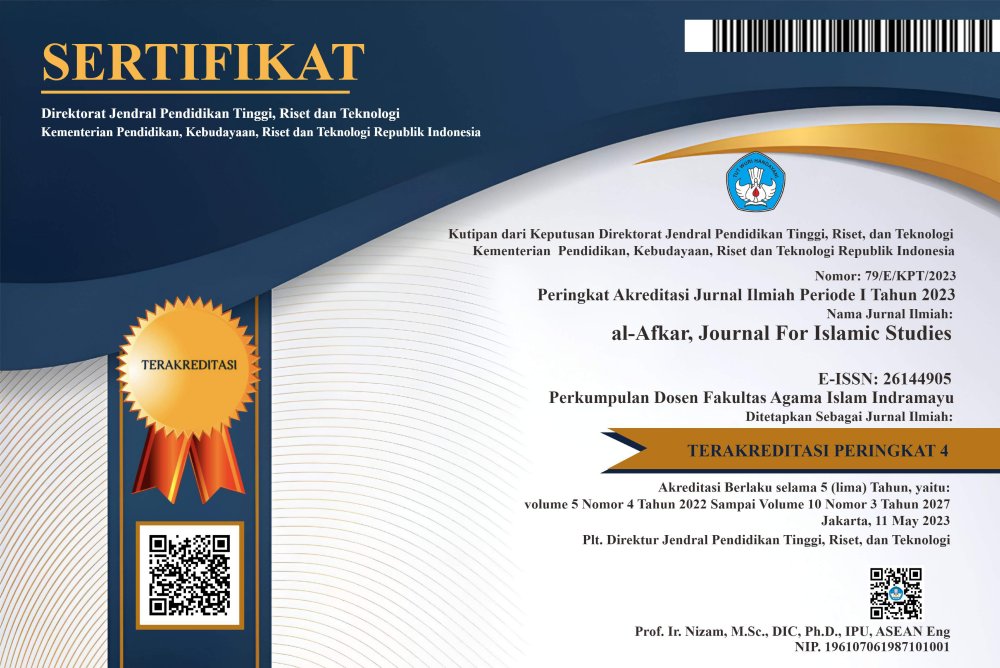Misperception Among Members of the Jabodetabeka Cirebon Student Community Organization (KMJC) (Intercultural Communication Study)
DOI:
https://doi.org/10.31943/afkarjournal.v8i1.1346Keywords:
Misperception, Intercultural Communication, OrganizationAbstract
Cultural differences and different languages will be very vulnerable to misperceptions such as what happened in the Jabodetabeka Cirebon Student Community organization (KMJC), in this regional organization there are two different tribes, namely the Betawi tribe and the Sundanese tribe. Members from these two tribes often misperceive each other in form, language, speech intonation, and have different habits that give rise to misperceptions. This research uses a qualitative descriptive method with a case study approach, the data sources used are primary and secondary. Data collection techniques in data research used in this research are observation, interviews and in-depth documentation with data analysis techniques using case studies. The aim of this research is, among other things, to find out the causes of misperceptions among members of the Jabodetabeka Cirebon Student Community (KMJC), to find out how to overcome misperceptions between members in the Jabodetabeka Cirebon Student Community (KMJC), to find out what kind of social communication methods are carried out between members in the organization to reduce misperceptions that occur. The results of this research show that misperceptions that occur among members of the Jabodetabeka Cirebon Student Community (KMJC) occur due to differences in linguistic culture involving Sundanese and Betawi tribes in the Jabodetabeka Cirebon Student Community (KMJC), how to overcome misperceptions that occur among members of the Student Community Jabodetabeka Cirebon (KMJC), namely by means of which members are expected to understand the character and characteristics of other members, respect each other among individual members even though they have different cultures, each member must have a sense of empathy and sympathy for other members. If a conflict occurs, resolve it using tabbyun, consensus, and professionalism in dealing with conflict.
Downloads
References
QS Al- Hujurat Ayat 6
Ariefianto, L. (2017) Homeschooling: Persepsi, Latar Belakang dan problematikanya (Studi kasus pada peserta didik di homeschooling kabupaten Jember) Jurnal Edukasi, 4(2), 21-26
Bimo, Walgito. (2010). Pengantar Psikologi Umum.Yogyakarta: C.V Andi.
Febriansyah, A. (2019). Pola Komunikasi Organisasi Komunitas Mahasiswa Jabodetabeka Cirebon (KMC) Dalam Menghadapi Konflik Internal. Jurnal Skripsi IAIN Syekh Nurjati Cirebon.
Hasanah Hasyim. (2015) Pengaruh Komunikasi Interpersonal Dalam Menurunkan Problem Tekanan Emosi Berbasis Gender. Jurnal SAWWA. Vol. 11, No. 1. 55-56.
Kusumawati, T.I (2016). Komunikasi Verbal Dan Non Verbal. Jurnal Pendidikan Dan Konseling, 83-98.
Irpan. (2019). Komunikasi Antar Budaya Di Kalangan Mahasiswa (Studi Deskriptif Kualitatif Pada Strategi Komunikasi Akomodasi Mahasiswa Suku Mandar dengan Mahasiswa Suku Jawa di Berbagai Universitas di Yogyakarta). Jurnal Skripsi UIN Kalijaga Yogyakarta.
Liliweri, A. (2003). Dasar Dasar Komunikasi Antarbudaya. Yogyakarta: Pustaka Pelajar Offset.
Mardolina, Y. (2015). Pola Komunikasi Lintas Budaya Mahasiswa Asing dengan Mahasiswa Lokal di Universitas Hasanuddin. Jurnal Skripsi Universitas Hasanuddin Makassar.
Moleong, Lexy J. (2018). Metodelogi Penelitian Kualitatif. Bandung: PT Remaja Rosdakarya Offset.
Mulyana, Deddy. (2019). Pengantar Komunikasi Lintas Budaya. Bandung: PT Remaja Rosdakarya Offset.
Patriana, E. (2014). Komunikasi interpersonal yang berlangsung antara pembimbing kemasyarakatan dan keluarga anak pelaku pidana di bapas surakarta. Jurnal rural and development, 5, 1-12.
Robbins, S.P. (2023). Prilaku Organisasi (Jilid 1). Jakarta: PT Indeks Kelompok Gramedia.
Ridwan, A. (2016). Komunikasi Antar Budaya. Bandung: CV Pustaka Setia.
Sihabudin, A. (2011). Komunikasi Antar Budaya (Satu Perspektif Multidimensi). Jakarta: Sinar Grafika Offset.
Suryani, W. (2013). Komunikasi Antar Budaya yang efektif. Jurnal Dakwah Tabligh, Vol: 14, No 1. IAIN Sultan Amai Gorontalo.
Sugiyono. (2016). Metode Penelitian Kuantitatif, Kualitatif, dan R&D. Bandung: Alfabeta.
Yuliani, W. (2018). Metode Penelitian deskriptif kualitatif dalam perspektif bimbingan dan konseling. Quanta, 2 (2), 83-91
Downloads
Published
How to Cite
Issue
Section
License
Copyright (c) 2025 Udzri Dhiyaul Suyanto, Rahmawan Hidayatulloh

This work is licensed under a Creative Commons Attribution 4.0 International License.



















